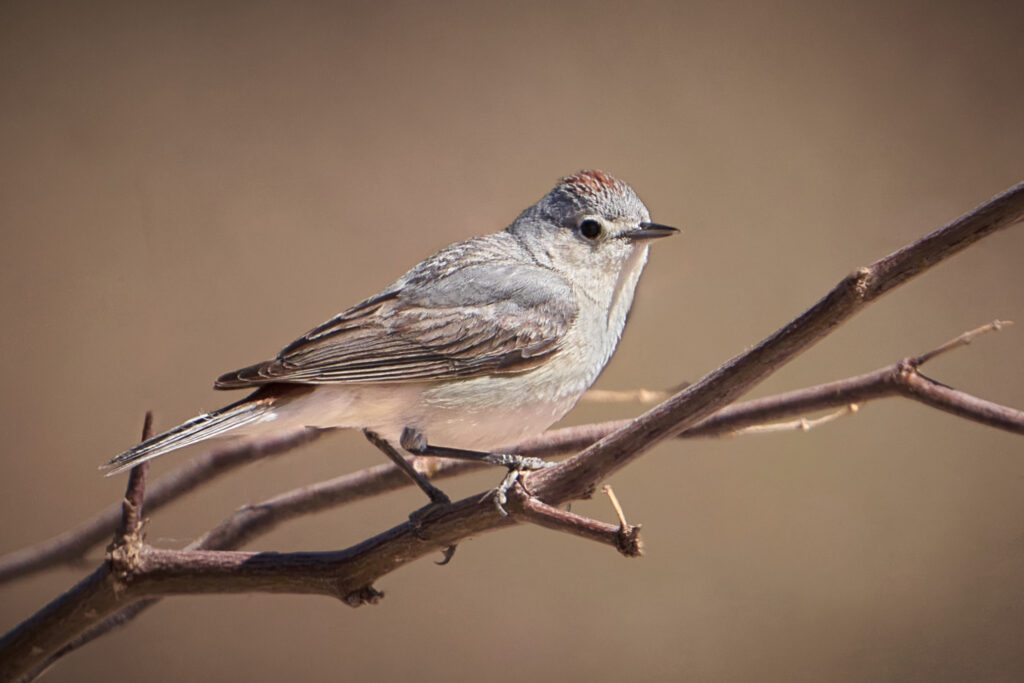Lucy’s Warbler (Leiothlypis luciae) is the first warbler heard singing around Las Vegas in the spring.
In 1861, ornithologist and surgeon James Graham Cooper found Lucy’s Warbler along the lower Colorado River near Fort Mojave, Arizona—the site where present-day Arizona, California, and Nevada come together. Although many naturalists had traversed this region in previous decades, they had overlooked the tiny Lucy’s Warbler.
Lucy’s Warbler was named in honor of Lucy Hunter Baird, the daughter of ornithologist Spencer Fullerton Baird, the second secretary of the Smithsonian Institution. The species is sometimes also called “mesquite warbler” and “desert warbler” to indicate its preferred habitat.
They have a small range and are found mostly in the Sonoran Desert with Southern Nevada being near the northern extent of their range. They winter along western edge of Mexico.
Their plain light colored plumage helps keep them cool in the Las Vegas summer. Lucy’s Warblers often sing late into the morning, when other nesting songbirds have retreated in the shade. They are also our only cavity nesting warbler, making nests in holes in trees and small rock crevices.
But, they are not easy to photograph.
So why are they hard to photograph?
- Lucy’s Warblers are well camouflaged. Their grey color blends in with the surrounding vegetation.
- They never sing from visible locations, like the top of shrubs or trees and are usually found in the middle of the vegetation.
- They also prefer the densely branched mesquite trees which makes getting the bird in focus almost impossible.
- They are bird ventriloquists. Lucy’s Warblers have a high pitched trill song that makes locating the bird very challenging.
- Lucy’s Warbler are hyperactive. They eat primarily insect and zip around the vegetation rarely pausing.
Capturing this Image
I dealt with several challenges in capturing this image.
- I was photographing this bird at 10:00am in harsh light. If you look closely, you can see the shadow created by the birds bill and which shows how high the sun was in the sky.
- The bird was moving in between the shade and sun. I needed to set my shutter at 1/2000 second to freeze the hyper bird.
- I was using multi-metering mode. I probably should have been using center or spot metering. I quickly adjusted the exposure compensation to deal with the sun/shade issue.
- As a result, I overexposed this image.
Post Processing
If had had been shooting in .JPG, I would have ruined the images. Luckily, I was shooting in RAW which allows more control when editing in post.
- I darkened the head and chest area of the bird.
- I also darkened the overall image.
- I cloned out some of the distracting branches.
- I also added some vignetter to the corners of the images.


Exposure Program: Aperture priority
Exposure Time: 1/2000
FNumber: 7.1
(ISO): 1,250
Metering Mode: Multi
Focus Mode: Spot
Exposure Bias Value: 1.3
Exposure Mode: Auto exposure
White Balance: Auto white balance
Focal Length: 600mm
Camera: Sony A7RIV
Lens Model: Sony FE 200–600mm F5.6–6.3 G OSS



